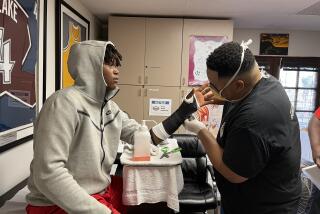The science of keeping players in the game
A nagging injury can sap motivation, sometimes permanently, derailing the workout programs of even the most hard-core fitness buffs. But orthopedic surgeons, biomechanicists, exercise physiologists and physical therapists at Duke University are here to help.
The Michael W. Krzyzewski Human Performance Research Laboratory, launched in 1997 and named after the Duke men’s basketball coach, is a sports medicine facility devoted almost exclusively to injury prevention. Many of the strategies developed there -- particularly in weight lifting, soccer, tennis and baseball -- have been adopted by professional and national teams around the world.
Among the lab’s recent projects: creating a warm-up routine specifically for female basketball players.
Injury prevention is a top focus of orthopedic sports medicine research, says Robin M. Queen, coordinator of sports biomechanics at the so-called K Lab.
“Whatever the problem -- whether it’s foot fractures or knee injuries -- we always see if we can come at it from a prevention standpoint,” she says. “Our goal is to keep people playing.”
The researchers’ discoveries ultimately could help everyone engaged in athletics. A case in point: The warm-up routines recently devised for the women’s basketball team can be used by athletes of all ages who play court and field sports, helping them be more agile, quicker and faster.
The sudden stops, starts and pivoting movements that are an integral part of basketball make players prone to ankle sprains, hip injuries and tears in the knee’s anterior cruciate ligament (ACL) (an injury that is particularly common in women). Athletes know it’s important to warm up muscles before doing strenuous exercise, says Mike Huff, coordinator of sports performance at the lab, but stretching alone is not enough to prepare bodies for the rigors of a workout or practice.
Consequently, the Duke team devised a 15-to-20-minute warm-up routine that included exercises to enhance balance, strength, coordination, agility, power and flexibility.
The regimen was tested on members of 13 girls’ basketball teams from Durham area high schools. About 150 players did the warm-up program three times a week for six weeks; a roughly equal number of players did their usual warm-ups. The rate of injury for the training group was 11.5%, versus 34.2% for the control group. Of those injuries, 5.7% in the training group required players to be benched for three days or more, compared with 12.3% of the controls.
“The warm-ups prevented injury, and when the players did get hurt, their injuries were less severe,” says Huff. “And what was truly amazing is that two of the teams had no injuries, and we didn’t see one ACL tear.”






